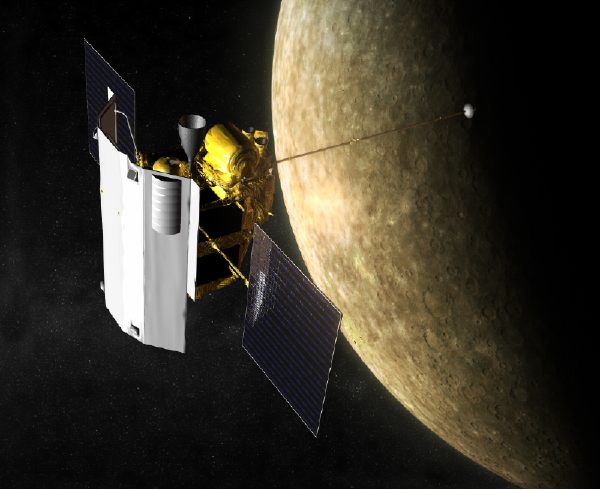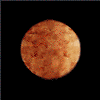 |
||||
| Mercury | Messenger | BepiColombo | Resources | Planets |
The Planet Mercury:
It's Hot, Heavy and Inhospitable
Latest news from the MESSENGER »»
Closest to the Sun. Mercury orbits very close to the Sun at a distance of only about 36 million miles. That's 0.387 astronomical units (AU) from the Sun. In other words, it's only about 39 percent as far away from the Sun as is the Earth.
Mercury is in a highly eccentric orbit around the Sun. At its closest (perihelion), it is only 28.6 million miles from the Sun while, at its most distant (aphelion), it is 43.5 million miles. Its orbit perihelion moves backward (precesses) around the Sun at a very slow rate.
The planet's diameter is a mere 3,031 miles. Its mass is a heavy 7.27525465×1023 pounds.
Mercury surface temperatures range from –456.842567°F to –437.678851°F. That is the most extreme in the Solar System. While the temperature on Venus is slightly hotter, it is very stable.
Discovering and naming Mercury. Human observers have been looking up at Mercury since at least the time of the Sumerians – the 3rd millennium BC. The planet had two Greek names – Apollo when it appeared as a morning star and Hermes when it appeared as an evening star. However, those Greek astronomers were aware that their two names referred to the same Solar System body. One of those observers, Heraclitus, even said he believed that the planets Mercury and Venus both orbited the Sun, not the Earth.
Mercury was the god of commerce, travel and thievery in Roman mythology. He was the Roman counterpart of Hermes, the Greek messenger of the Gods. The planet probably was named Mercury because it seemd to move quickly across the sky.
Mercury At A Glance Average Distance from Sun 35.98 million miles convert mi to km Diameter 3,032 miles Volume 0.054 of Earth Mass 0.012 x 1027 ounces or 0.055 Earth's mass Density 5.43 gm/cm3 Gravity on surface 0.376 Earth's gravity Length of day (rotation period) 58.65 Earth days Length of year (revolution period) 87.97 Earth days Surface temperature:
Average
Maximum
Minimum
354° F
800° F
280° F convert F to C or KNatural satellites None Atmosphere hydrogen and helium traces Largest surface feature Caloris Basin – 839 miles in diameter Escape velocity 9,619 mph Orbit:
Inclination
Eccentricity (deviation from circular)
Obliquity (axis tilt)
7 degrees
0.206
0 degreesReflectivity (visual geometric albedo) 0.12 source: NASA Jet Propulsion Lab
We've explored the planet. Mercury was visited by one American spacecraft, Mariner 10. It flew by the planet three times in 1973 and 1974. Only about 45 percent of the surface was mapped. In case you're wondering, Mercury is too close to the Sun to be safely imaged by the powerful Hubble Space Telescope.
Back in the nineteenth century, astronomers made very careful observations of Mercury's orbit, but they could not explain the orbit adequately using Newtonian mechanics. The tiny differences between what they the observed and the mathematically-predicted values were a nagging problem for decades.
Most thought that another planet – which they called Vulcan – might exist in an orbit near Mercury. They said that could account for the discrepancy. However, the truth turned out to be much more dramatic.
Mercury
Einstein's General Theory of Relativity correctly predicted the motions of Mercury. That astounding event contributed to early acceptance of Einstein's theory.
Should we explore Mercury again?
Long hot days. Until the 1960s, astronomers thought Mercury's day was the same length as its year. That would allow the planet to keep its same face toward the Sun just as the Moon does to Earth. But, doppler radar observations in 1965 showed that to be false. We now know Mercury rotates three times in two every two Mercury years.
Strange views. Speaking of rotation, Mercury is the only body in our Solar System with an orbital-rotational resonance ratio other than 1:1. Astronomers imagine that the odd ratio, along with the high eccentricity of the planet's orbit, would produce some very strange effects for anyone standing on Mercury's surface.
At some longitudes the observer probably would see the Sun rise and then gradually increase in apparent size as it slowly moved toward the zenith. Then the Sun would stop, reverse course briefly, and stop again before resuming its path toward the horizon and decreasing in apparent size. While that was going on, the stars would be moving three times faster across the sky. Observers standing at other points on Mercury would see different, but equally bizarre motions.
Like the Moon? Mercury's appearance from a distance is in many ways similar to the Moon:
MercuryMercury is much denser than the Moon (5.43 gm/cm3 vs 3.34). In fact, after Earth, it is the second densest major body in the Solar System. Actually, Earth's density is due in part to gravitational compression. If not for that, Mercury would be denser than Earth. Apparently, Mercury's dense iron core is larger than Earth's. It may even comprise the majority of the planet. Mercury probably has a relatively thin silicate mantle and crust.
- Its surface is very old
- Its surface is heavily cratered
- It seems to have no plate tectonics
Mercury's interior probably is dominated by that large iron core whose radius would be 1118-1181 miles. The silicate outer shell – like Earth's mantle and crust – is only 311-373 miles thick. At least some of Mercury's core must be molten.
Thin atmosphere. The planet actually does have a very thin atmosphere of atoms blasted off its surface by the solar wind. Because Mercury is so hot, the atoms quickly escape into space. In contrast to Earth and Venus where atmospheres are stable, Mercury's atmosphere is constantly being replenished.
Rugged terrain. The surface of Mercury has enormous steep slopes and long cliffs from erosion or faulting (escarpments), some hundreds of miles in length and up to two miles high. Some of the cliffs cut through rings of craters and other surface features in such a way as to indicate that they were formed by compression. It is estimated that the surface area of Mercury shrank by about 0.1 percent. That would represent a decrease of about two thirds of a mile in the planet's radius.
One of the largest surface features is the Caloris Basin, which is about 800 miles in diameter. It seems to be similar to the large basins (seas or maria) on the Moon. Like those lunar basins, the Caloris Basin probably was caused by a very large impact early in the history of the Solar System. That impact may also have been responsible for the odd terrain on the exact opposite side of the planet.
In addition to its heavily cratered terrain, Mercury also has regions of relatively smooth plains. Some of the plains may be the result of ancient volcanic activity, but some may be deposits of dirt ejected from craters by impacts. A reanalysis of the old Mariner data revealed some evidence of recent volcano activity on Mercury.
Water? Amazingly, radar observations from Earth of Mercury's north pole – a region not mapped by Mariner 10 – turned up evidence of water ice in the protected shadows of some craters.
Molten core. Mercury has a small magnetic field whose strength is about one percent of Earth's magnetic field.
Recent radar observations from Earth, reported in 2007, have shown that Mercury has a molten core. Once, scientists had thought the planet had a solid iron core until the interplanetary probe Mariner 10 discovered in 1974 that Mercury has a weak magnetic field, which indicated a molten core.
Mercury spotting Mercury often is visible from earth with binoculars and sometimes even the naked eye. However, the planmet always is very near the Sun and difficult to see in the twilight sky.Mercury has no known satellites.
- Planet finder charts show the sky position of Mercury and the other planets.
- A planetarium program such as Starry Night creates detailed custom charts.
What do we want to know about Mercury?Now we're going back for another look.
- What process produced Mercury's smooth plains?
- No iron has been seen in spectroscopic studies of the planet's surface. That's odd given its presumed large iron core. Is Mercury differentiated more than the other so-called "terrestrial planets" of the inner Solar System?
- Mercury's density is almost as great as Earth's. However, it otherwise resembles our Moon. Did the planet lose its lighter rocks in a catastrophic impact?
- Are there any surprises on the unseen half of Mercury? Low-resolution radar images from Earth showed . . . no surprises.
Learn more about the planet Mercury »»
Learn more about the MESSENGER spacecraft »»
Learn more about the planet Mercury and the MESSENGER probe »»
Read more about the Solar System . . . Star: The Sun Inner Planets: Mercury Venus Earth Mars Outer Planets: Jupiter Saturn Uranus Neptune Pluto Other Bodies: Moons Asteroids Comets Beyond: Pioneers Voyagers


